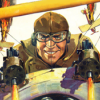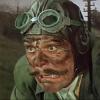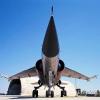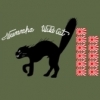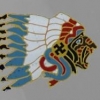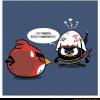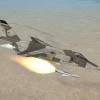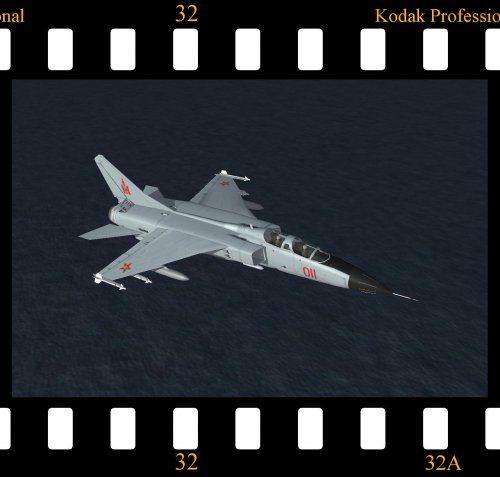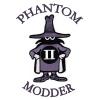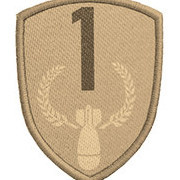Leaderboard
Popular Content
Showing most liked content on 05/21/2018 in all areas
-
6 pointsGod I miss Hi-Vis colors....TA-4J of VF-126 "Bandits" during America's Bi-centennial 1976.
-
6 points
-
5 points
-
5 points
-
4 pointsLined up, Flaps down, Gear out..........Screw it........suck it all in and blow down the runway at 100% mil power. Also, I do enjoy the Angola Terrain. It gives such a sense of.....emptiness. And yes, there is a Mirage F-1 in the shot.
-
3 pointsAvro Canada CF-103 Archer - No.425 Squadron, Royal Canadian Air Force, 1963 Serving with no less that nine front-line RCAF squadrons at its peak in the mid-1950's, the Avro Canada CF-100 Canuck provided all-weather defense against Soviet intruders and the four Canuck squadrons based in Europe from 1956 to1962 were, for some time, the only NATO fighters capable of operating in zero visibility and poor weather conditions. However, recognising the fact that the Soviet Union was working on newer jet-powered bombers the RCAF began looking for a missile-armed replacement for the CF-100 even before it had entered service and in January 1953 the RCAF's All-Weather Interceptor Requirements Team submitted a report to the Canadian Government outlining their requirements. In response, Avro Canada came up with three distinct proposals; 1. A subsonic CF-100 development with a thinner swept wing and tail surfaces and with external missile stores (CF-100S). 2. A single-seat supersonic delta-winged aircraft with twin engines and external missile stores (CF-103). 3. A large two-seat supersonic delta-winged aircraft with twin engines and an internal missile bay (CF-105). After a full year of reviewing Avro Canada's proposals the RCAF announced in February 1954 that they considered that the CF-103 represented the optimum balance between cost, efficacy and in-service date and requested that Avro Canada should be awarded a production contract for 200 CF-103's. To keep costs down the RCAF stipulated the use of two key 'off the shelf' items; the Hughes MA-1 fire control system (from the Convair F-102A) and the Rolls-Royce Avon afterburning turbojet (from the English Electric Lightning). Whilst both items were actually still under development themselves, they were considered to be a safer choice than any home-grown paper project and likely to reach maturity for the projected in-service date of 1960. The only area of risk was the decision to arm the CF-103 with the radical British ADEN 230 twin-barreled cannon in a streamlined semi-conformal installation carrying the cannon and with a 500 round ammunition drum stored immediately above and inside the fuselage. The CF-103 used the then fashionable delta-wing configuration but with slab tailplanes and, in order to house a large radar set, the CF-103 used a solid nose with variable geometry air intakes on the fuselage with intake ramps and splitter plates which proved to be a perfect match for the Avon RB.146 turbojet engines each rated at 12,500 lbs thrust dry and 16,500 lbs thrust with afterburner. The aircraft was intended to be built directly from the production line thus skipping the traditional hand-built prototype phase and luckily very little re-design was required as testing progressed. On October 4th 1957, the same day as the launch of Sputnik 1, the first CF-103A was rolled out at Avro Canada's facility at Malton, Ontario eventually making it's first flight on December 30th, 1957 with Chief Development Test Pilot Janusz Zurakowski at the controls. Flight testing quickly demonstrated excellent handling and overall performance, reaching Mach 2.1 in level flight. Development was slowed slightly due to problems with the Hughes MA-1 Fire Control System and the ADEN 230 twin-barreled cannon but the first two CF-103A's entered service with No.425 Squadron on August 15th, 1961 in a ceremony at RCAF Namao, Alberta becoming fully operational by the end of the year.
-
3 pointsAs some have noted, I've started doing some small modifications and tweeks to some of our ww2 aircraft. It should be noted, that I'll -ONLY- be adjusting/modifying those aircraft that are available here at CombatAce. The first ones to be worked on will be those for the European Theatre. As noticed, instead of starting new threads, I'll be uploading them to the "Tips & Tweeks" thread pinned above. Most will be adjustments on hit boxes and adding "armor skin" (the thickness of the skin, as Baff once said "structure as armor"). Unfortunately, many, if not most of these aircraft, do not have the proper "cuts" to their meshes. Meaning, for example, wings are one piece from root to tip, with the "outer***wing" statement" defining a nonexistent mesh. Same is also true for fuselages lacking the nose, fuselage and tail statements. These will be adjusted to remove the missing meshes. Also unfortunately, some of these aircraft, no matter how exact you copy the min/max numbers simply don't take the changes. So, there will be aircraft that will remain in their "as issued" state. At note to 3d modlers -- it is vitally important that any new aircraft follow the 3W style, in creating the various named sections in the LOD. This not only helps for decals, but for flight and damage modeling. So, watch the Thread above for more packages as I get them finished. I'll try to remember and included the original, "already backed up" data inis
-
3 pointsThank you. I will add that for more proper operation of the engines, some parameters in the "Engines" section of the DATA file should look like this: // Engines --------------------------------------------------------- [EngineL] ................................................... SpinnerNodeName=SpinPropHub StaticPropNodeName=StaticPropL SlowPropNodeName=SSpinProp01 FastPropNodeName=FSpinProp01 ................................................... [EngineR] ................................................... SpinnerNodeName=Object52 StaticPropNodeName=StaticPropR SlowPropNodeName=SSpinProp02 FastPropNodeName=FSpinProp02 ...................................................
-
3 pointsAssisting VonS and myself are two other guys with excellent backgrounds: Mike Dora and jeanba. Jeanba is a consultant who has helped with structural and operational research, while Mike is a retired RAF squadron commander who is also active at the Old Rhinebeck Aerodrome in upstate New York. Some shots and recent comments below: "Well I hope it flies better than our Rhinebeck Caudron G.3. On a good day they get it to run straight down the field with 4-5 feet of daylight beneath the wheels. Actually this machine is the worst we have for ground handling. Those struts and booms may look delicate at a distance, but close up they are thick and heavy, the tail booms are like old-fashioned wooden clothes poles! Plus with the length of ground contact of those lower booms, it is a bit of a pig to manhandle." Shameless plug: a new Sopwith Dolphin will be ready for their 2018 season, so if any fans are in upstate New York this summer, drop by the aerodrome.
-
3 pointsHere are some photos to expand on VonS' excellent research and FM work. A Swedish replica builder is constructing an all-new D.8 the same way the originals were made and it will be powered by an original Siemens-Halske engine! D.8s were issued in ones and twos to front line and home defense units in the Spring of 1918. Paul Baumer, of Jasta Boelcke, obtained a D.8 in May per the Osprey pub Pfalz Scout Aces of WW1 which has a photo of two D.8s used by Jasta 29 alongside their Fokker D.7s. Myself, I tend to agree with VonS and suspect D.8s were not operational until late summer/early autumn - but I've been wrong before!
-
3 pointsSome more stats. for those enjoying Geezer's Pfalz D.8 WIP and its FM: A lovely aircraft to fly, takes off well at around 100 kph, stall speed is around the low 70s kph. Top speed near sea level is about 193/4 kph, the climb rate in the 120s and 130s kph to about 3000m alt is excellent - about 5-6 m/s. Avoid tight turns if slower than about 150kph however since she tends to slip out of a turn with the thin wings. Loops are easier than on the Pfalz D.3 (tighter loops possible), but be gentle on back stick anyway. Modern Immelmann's are easy to do on the type (the engine has more than enough power). Overall a more pleasant and powerful plane to fly than the Pfalz D.3/3a line, similar to the Triplane variant but not as quirky and with a slightly slower climb rate. Slightly tougher to break than the Pfalz Triplane also...can do about 5.5 Gs as historical for these later war German types. Also, an excellent diver; I managed to get her up to about 450kph in a dive - as long as you exit the dive fairly gently you won't lose any pieces. Ceiling is about 6000m on the type; the uncompressed Siemens-Halske has about 210hp max output (historically) at full throttle but even half throttle is significant, giving out around 130-150hp I'd say. I doubt the D.8 (Pfalz) was used on the front any earlier than about Sept. of 1918 (I think a total of about 40 were made before the armistice) - so it should be set to rare or very_rare. Note: the D.8 had several different power-plants installed, ranging from about 145hp to 200/210hp...this explains the different top speeds available for it all over the internet, from as low as the low 180s kph to about 190kph for the 160hp variant, etc. I've gone with an engined-up (uncompressed) variant for this particular FM. Von S
-
3 pointsTweeks/Adjustment for Veltro2K's Dornier Do-17Z light bomber New/Remodded data ini includes: -ALL hit boxes adjusted -light aluminium "skin" armor added -AvHistory BMW engine sound Flight model remains untouched, in as issued state Instructions: unzip and install to your ETO mods folder. A back-up (original) copy of the data ini is included, for safety's sake. v2k_do17z_tweeks.7z
-
2 pointsRAF units that used the Spit V.a with operational dates, short info and sqn codes: No 26 Sqn: Mar-Nov 1944 Artillery spotters for the Royal Navy, RM No 54 Sqn: May-Nov 1941 Fighter, KL No 66 Sqn: Feb-Mar 1942 Fighter, LZ No 116 Sqn: Oct-Dec 1942 Anti Aircraft Calibration Unit, II No 130 Sqn: Oct-Dec 1941 Fighter, PJ No 133 Sqn: Jan-Mar 1942 Fighter (Eagle Squadron), MD No 134 Sqn: Dec 1941-Feb 1942 No 154 Sqn: Feb-Apr 1942 Fighter, HT No 164 Sqn: Apr-Sep 1942 Argentine-British Sqn, FJ No 165 Sqn: Apr-Jun 1942 SK No 332 Sqn: Jun 1942-Apr 1942 AH (should be Jan instead of Jun...?) No 349 Sqn: Jun-Sep 1943 Belgian, GE These are what I have found so far. There may be others (though not likely due to the limited number this version was built in).
-
2 points
-
2 pointsBeautiful pics. of the Pfalz D.VIII - also interesting is the four-bladed prop made by putting two two-bladed ones together. A couple of other pics. below - featuring a one-piece four-bladed prop, and a 160hp Siemens-Halske variant with a nose similar to the Siemens-Schuckert. Von S
-
2 pointsI built it with the understanding that Quack74 would make the skins. Unfortunately, real life got in his way and he had to give up modding.
-
2 points
-
2 pointsAlso, below is the VERY ROUGH Caudron R.11. I "borrowed" Stephen1918's excellent Caudron G4 files, and substituted my R.11 model for his G.4 model. Anyone interested in developing new ini files is welcome to try their hand. WIP Caudron R11.rar
-
2 pointsStill busy with the Real World, but spent the morning working on Breguet 14 gunner and armament.
-
2 points
-
2 points
-
2 points
-
2 points
-
2 points
-
1 pointHi Guys, as some of you already now, i have some fake pilot mods in the pipe for the Eagle and the Flanker. What it does is, it replaces some parts of current planes, like the canopy, glass and the cockpit itself. BUT!!! You need to decide and choose just one skin for each plane, cause if you choose a different coloured skin, the "new" exterior parts, will not change with the skin. So you are limited in one or the same coloured skin for the planes. And!!! You will lose the open canopy animation for the Eagle. The Mod is using Marcfighters Su-27 and Dave's F-15 Pack as base. This is not a mod for TK's F-15A or Inskies Su-27 Currently i need some helpf fixing the problem, that the new fake pilot parts appear inside the cockpit, how can i dissable them? And here it is, what i am talking about: F-15C Su-27
-
1 point
Version 1.0.0
290 downloads
SF2 WW2 Spitfire Mk.VA by Coupi/Mod Mafia/TMF 5/10/2018 = For SF2, Full-4/5 Merged (Reccomended/Preferred) = *Note: This mod may not work in SF/Wo* 1stGen game installs at any patch level, due to the excessive modifications made to fit them into the SF2 environment. End Users (tm) that attempt to do so, do so at their own risk.* This is a modification of the TMF Spitfire MK.1A to the early VA version; this mark uses the "A" wing with 8 303 caliber machine guns. This is the Vickers/Supermarine Spitfire Mk.VA. This pak contains skins/decal set for the following RAF Squadrons: No. 92 There are 2 skins; one Dark Earth/Dark Green/Sky (pre-1942) and Medium Sea Gray/Dark Green/light grey for post-1942. The SF2 Date Switch is used to turn on the later skin in November, 1941 All skins are in jpg format, Decal Randomization is TRUE. Serial numbers, while not matched to plane-in-squadron letters, are all correct for Mk.Vs used by 92 Squadron. Those marked with a star (*) fall into the correct sequencing for those aircraft built as the 8-gunned Va version. The canopy/entry door open with the Standard Animation Keystroke (tm), Shift/0. For those RAF Squadron listed in the game's SquadronList.ini, my 'fake sqtail' decal will activate their "Displayed Name" on the LoadoutScreen. When 'in game', you'll see "Spitfire Mk.Va (TMF)" on the aircraft drop-down selection window. The Official Squadron Crest (tm) is used for the 'paint chip' for each skin. As always, fairly easy to follow, highly detailed install instructions are included. So, please READ them. Also, give the "Notes" section a read too for futher explinations, clarifactions, illuminations and so forth. Good Hunting! ------------------------------------------------ =TO INSTALL: As I always reccomend, unzip the "sf2_ww2_eto_spit5a_tmf_pak.zip" to a temp folder or your desktop or somewhere else that's easy to find Then, simply, copy/paste the Objects folder supplied directly =OVER= your existing /Objects folder. Copy/Paste the Sound folder over your existing /Sounds folder. Odds are, you have the engine sound already, but I like to upload as complete as possible products You'll probably be asked "OVERWRITE?", just say Yes. I've already seperated out the various folders (Aircraft, Decals, etc), so they'll drop right where they're supposed to be. ---------------------------- Historically, No.164 Argentine-British also flew the Va. They used the "FJ" code on their aircraft. I'm sure there are other units, but haven't been able to run them down accurately. So, it's easier to just stay with No.92, as the Vb & c cannon armed versions were soon in service. As this aircraft LOD lacks the hardpoints the Mk.V had, I've used the Fake Pilot Method (tm) to add ONLY the centerline station for a drop tank. --------------------------------------------------------------------------------- Credits: Coupi for the idea and all major ini work (Many thanks to Wrench!!!) Bpao for the aircraft Kesselbrut for the cockpit PappaRomeo for the modded EAW gunsight pak, the RAF Mk II used here AVHistory for the Merlin engine sound Me ("Bob") for some new serial decals and ini Work, and the MSG/DG skin Sources: I'm not even gonna try to find all my RAF Spit books.... --------------------------------------------------------------------------------- Happy Hunting! -------------------------------------------- Legal BS: This is freeware; it CANNOT be re-distrubuted even if the original readmes and all other pieces of the package remain intact. This aircraft is fully owned by The Mirage Factory/Mod Mafia. Skins for this aircraft can be made, with no permissions needed The names of all contributors, modders, suppliers, etc =MUST= be listed in any new readmes. This package may NOT in any way, shape or form be used in any payware additions. Bribes are accepted; ask for the day's going rates ------------------------------------------- -
1 pointOnly as betas, but worth it! https://www.sas1946.com/main/index.php/topic,58588.0.html
-
1 point
-
1 pointA-4C.....95% it was the first production A-4 with a typical radar with CRT display. AN/APG-53A was definitely just a surface radar with terrain clearance, and ground search modes and a ground ranging function. The 53A was on USN A-4C/L/E/F and TA-4F/J AN/APG-53B had the same modes but added a TV mode for Walleye....(.Same for Mavs??) The 53B was on USN A-4E/F/ (M ?) and TA-4F/J (and others I expect A-4G) AGM-45 are specified loadouts on USN A-4E/F/M Chaff dispensers (ALE-29A) were on USN A-4C/L/E/F by 1970 but may have been added at different times during the late 60s Argentine A-4s may have been supplied with MK-82s (photo) but seemed to have used Mk 17 1,000lbs during the campaign.
-
1 point
-
1 point
-
1 pointAre there any antennas missing on the F-15C from TMF? so i could pack them into the cockpit parts, but im not an Eagle expert
-
1 pointFor those testing out Geezer's lovely WIP models for the Caudron R.11, also the Pfalz D.IIIa (not the D.III) - included below are the latest FM tweaks. The R.11 has a top speed of about 191kph near sea level - is fairly maneuverable too and can perform a modern Immelmann. Also included are some cockpit seating tweaks for the R.11. The D.IIIa file is not interchangeable with the Pfalz D.III (that download, in this thread, already contains the latest FM - the D.IIIa download is under the screenshots thread). Von S Edit: R.11 data ini has been removed, replaced with newer version posted below in this thread. Also removed is the Pfalz D.IIIa file. Please see the all-in-one download in this series of posts.
-
1 pointFully agree about Jonathan and AngelP, I miss a nice cockpit, especially for the early AJ-37 :( Image :
-
1 pointHello everybody, The time has come to tell you more about the historical timeframe of Battle of Bodenplatte. As we said in our previous Dev Blog #192, we're making all four different seasons for this map. Some might think that we'll model only 1-2 days of the actual Bodenplatte operation when the Luftwaffe made the all-out attack on the Allied airfields near Brussels and Antwerp. However, our “Battle of” series is much more than that! The Career mode for this new theatre of war will last from September 17th, 1944 to March 28th, 1945 – 188 days of war in total. Historically, 11 significant engagements took place in this area during the given timeframe. In the Career mode, you'll see your area of operations, mission types, acting air force units, their home airfields and other details that correspond to the historical data. You'll be flying in and around many famous operations and battles. Of course, we can’t model every skirmish or battle on the ground, but we will have an exciting Career spanning this later stage of the war when the Allies were fighting their way into Germany. Operation Market Garden (September 17 – 26, 1944) Battle of Aachen (October 2 – 21, 1944) Battle of the Scheldt (October 2 – November 8, 1944) Operation Queen (November 16 – December 15, 1944) Operation Watch on the Rhine (December 16 – 25, 1944) Allied Counter-Offensive (December 26, 1944 – January 25, 1945) Operation Bodenplatte (January 1, 1945) Operation Veritable (February 8 – March 10, 1945) Operation Clarion (February 22 – 23, 1945) Operation Grenade (February 23 – March 10, 1945) Operation Plunder (March 23 – 28, 1945) As said above, we won't be able to recreate these ground operations in super detail, but the overall situation, mission tasks, home airfields and mission targets will change as they should historically just as you experience with Stalingrad, Moscow and Kuban. This, along with the corresponding features of the Career mode like pilot biographies, squadron histories, newspaper articles, videos, squadron rosters, medals and rank progression will create an authentic experience of flying on the Western Front during the late war period. The whole timeframe will be divided into 5 chapters: Chapter 1: Fighting in Holland (September 17 – October 1, 1944) Chapter 2: Autumn Offensive (October 2 – December 15, 1944) Chapter 3: Battle of the Bulge (December 16 – 25, 1944) Chapter 4: Allied Counter-Offensive (December 26, 1944 – February 7, 1945) Chapter 5: Battle of the Rhine (February 8 – March 28, 1945) To create this new theatre of war, a thorough research will be done on where the units of both sides were based, their tasks and what aircraft they used day by day. Two new award systems for the US and Great Britain are to be created from scratch, as well as the late war pilot models for Luftwaffe, RAF and USAAF along with their chutes. The Newspaper articles is a huge task on their own and takes several months to complete. If you’d like to help with this contact Jason. We also plan on making additional mission types for this unique location and timeframe. All in all, this will be a lot of work for us, but progress is already being made. For example, we have finalized the map boundaries and the airfield locations. This map is bigger than we initially planned (flyable area is 401 x 324 km - it is 129.900 sq.km) and several compromises will have to be made to make it a reality. It will stretch us to the limit of what is possible in our development schedule, but as with our other maps it will be really cool when it’s done. You can discuss the news in this thread
-
1 point
-
1 point
Version 1
221 downloads
Xian FBC-1M for SF1 This is a simple mod of the excellent JH-7A/FBC-1 released by Insky many years ago to give a fictional export version in service with the Mongolian Air Force. This is released 'as is' and really needs a good Chinese weapons pack, something I don't have in my SF1 installs or simply download the JH-7A. BACKSTORY Under Soviet pressure at the end of World War Two, the Republic of China was obliged to formally accept Mongolian independence. However, following the Communists victory in the Chinese Civil War, the People's Republic of China warmly recognised Mongolia's independent status and established diplomatic relations with Mongolia during 1949. Although Mongolia aligned itself with the Soviet Union during the Cold War both nations patiently came to agreement on border disputes and by 1986 they had begun to establish trade agreements that paved the way for the 1988 treaty on border control and the 1994 treaty of friendship. By 2002, China had become Mongolia's biggest trade partner and their largest source of foreign investment with China allowing the use of its Tianjin port to give Mongolia access to trade within the Asia Pacific region and, in return, giving China access to Mongolia's natural resources. In a move designed to bolster regional security China exported 20 Xian FBC-1 Flying Leopard fighter-bombers (the export version of the JH-7A) which entered service with the Mongolian Air Force in 2008. INSTRUCTIONS 1. Drop the FBC-1M folder into your Aircraft folder. That's it! CREDITS Thanks to TK for a great little game/sim. Thanks to Erwin_Hans for bringing the JH-7A to us back in 2009. And special thanks to everyone in the wider Third Wire community. Regards Spinners Version 1 - 15/05/18 -
1 point
-
1 point
-
1 point
-
1 point
-
1 point
-
1 point
-
1 pointI always find Recon missions to be challenging. It's fun to try and sneak into the area and cover the target without being spotted when using a platform not normally designed for it. Getting out is even more challenging.
-
1 point
-
1 point
-
1 point
-
1 point
-
1 point
Important Information
By using this site, you agree to our Terms of Use, Privacy Policy, and We have placed cookies on your device to help make this website better. You can adjust your cookie settings, otherwise we'll assume you're okay to continue..

